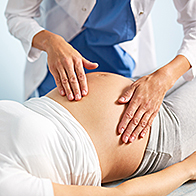Maternal Mortality Rates Rose During the First Year of the Pandemic

Maternal mortality rates increased in the first year of the pandemic in the United States, according to a new report by the National Center for Health Statistics.
As per the report, 861 women died due to maternal causes in 2020, compared with 754 deaths the previous year. The maternal mortality rate for 2020 was 23.8 deaths per 100,000 live births compared with 20.1 per 100,000 live births in 2019.
For non-Hispanic Black women, the rate was almost three times as high as that for non-Hispanic white women. Hispanic women also saw a significant increase in the mortality rate. The report noted that the rise from 2019 to 2020 for non-Hispanic white women was not significant.
The World Health Organization (WHO) defines maternal death as "the death of a woman while pregnant or within 42 days of termination of pregnancy, irrespective of the duration and the site of the pregnancy, from any cause related to or aggravated by the pregnancy or its management, but not from accidental or incidental causes."
The United States has the highest maternal mortality rate among high-income countries, and the rate has been increasing since 2000. Though the report does not mention reasons for the increase, it raises questions about potential explanations: Health disparities, the COVID-19 pandemic and cardiovascular conditions likely contribute to this trend.
Behind the increase in rates
While there's not just one cause behind the uptick of maternal mortality rates, it's hard not to draw the link between the increase in 2020 rates for Black and Hispanic women and the ravaging of COVID-19 on communities of color.
The American College of Obstetricians and Gynecologists (ACOG) expressed concern that the inequities in maternal mortality and morbidity could be exacerbated during the COVID-19 pandemic, said Jennifer Villavicencio, M.D., M.P.P., lead for equity transformation at ACOG in Washington, D.C.
"This concern is borne out through data, demonstrating that there are disproportionate rates of COVID-19 infection, severe morbidity and mortality in communities of color, particularly among Black, Latinx and Native American people," she explained. "Disparities were further magnified with the increase in the ratio of COVID-19-associated deaths among pregnant women as the Delta variant became predominant. At the same time, we faced tremendous disparities in COVID-19 vaccination of pregnant people.
"This latest report from the National Center for Health Statistics is further confirmation of these trends," Villavicencio said.
The report also noted that mortality rates increased with maternal age. For women ages 40 and older, the rate was 7.8 times higher than for women younger than 25. Women 40 and older have more chronic diseases, including hypertension, according to a 2015 study published in Geburtshilfe und Frauenheilkunde, the journal of the German Society of Gynecology and Obstetrics.
Another explanation for the increase could be that women with cardiovascular disease are at increased risk of complications during pregnancy, explained Donna Strobino, Ph.D., professor and vice chair of education population, family and reproductive health at Johns Hopkins Bloomberg School of Public Health in Baltimore. "Women with these underlying chronic conditions or with conditions that historically they've been advised not to get pregnant, are increasingly becoming pregnant."
Sixty percent of women giving birth in the U.S. have poor heart health, according to a 2022 article published in the American Heart Association's journal, Circulation. Poor heart health includes obesity, hypertension and diabetes—all of which can increase health risks for pregnant women.
Collecting data for maternal deaths
It's critical to understand how we classify and collect data indicating the trend of increased maternal deaths. On a positive note, the amount of reporting has likely increased over the years.
"Some of that trend is likely due to what is clearly the evolving nature of the surveillance for maternal deaths and the quality of the data reporting at any given state," Strobino confirmed.
However, the often-used 42-day cutoff for classifying maternal deaths might not give the most accurate information. A 2019 study published in the Journal of Maternal-Fetal & Neonatal Medicine about maternal mortality rates in New Jersey noted, "The usual approach to improving maternal mortality rates is to concentrate on pregnancy-related deaths up to 42 days after delivery." However, the study found almost 50 percent of pregnancy-related deaths in New Jersey occurred after 42 days.
Maternal Mortality Review Committees (MMRCs) are one way to collect proper data on maternal deaths. The Centers for Disease Control and Prevention (CDC) defines MMRCs as teams that perform comprehensive reviews of deaths among women within a year of the end of a pregnancy. "They include representatives from public health, obstetrics and gynecology, maternal-fetal medicine, nursing, midwifery, forensic pathology, mental and behavioral health, patient advocacy groups, and community-based organizations," according to the CDC website.
The New Jersey study noted the CDC recognizes that information about maternal mortality in the U.S. is imperfect, and "imperfect data gives flawed conclusions." The study authors called for a uniform process in the U.S. where each state reports maternal mortality using the same definitions and case review forms.
As for the current system, 49 states and the District of Columbia have MMRCs, yet the classification processes differ by state, according to the Guttmacher Institute, a reproductive health rights organization.
Only 36 states are required to review deaths for up to one year postpartum. Fourteen states are required to determine if a pregnancy-related death was preventable. Only six states require committee reports to address racial disparities. Forty-two states and New York City adopted a standardized review process developed by the CDC that includes consistent data gathering.
"Maternal Mortality Review Committees are the real nuts and bolts of how states can more accurately capture maternal deaths and think more about maternity interventions that might be needed within their states to reduce maternal mortalities," Strobino said.
We need to capture better information to know how to intervene and make improvements.
"Are we going to do better with the ascertainment of deaths?" Strobino asked.
Initiatives for improvements
Almost two-thirds of pregnancy-related deaths are preventable, according to the CDC. Recognizing urgent maternal warning signs can save lives so people can receive timely diagnosis and care.
One initiative for improvements is to use bundles of care, which are evidence-based interventions to improve outcomes, such as cardiac interventions in obstetric care. ACOG recommends a check-in within three weeks postpartum with an obstetric provider.
"There's a significant group of women who leave the hospital with no experience of severe morbidity and develop it de novo postpartum, and they're the group where there's not a recognition that there are potential signs and symptoms that they need to look at or that they are going to fall ill," Strobino said.
"The next step is really to think about how we might intervene in the community to help identify women who potentially experienced severe maternal morbidity and potentially are at risk of death," Strobino concluded.




















